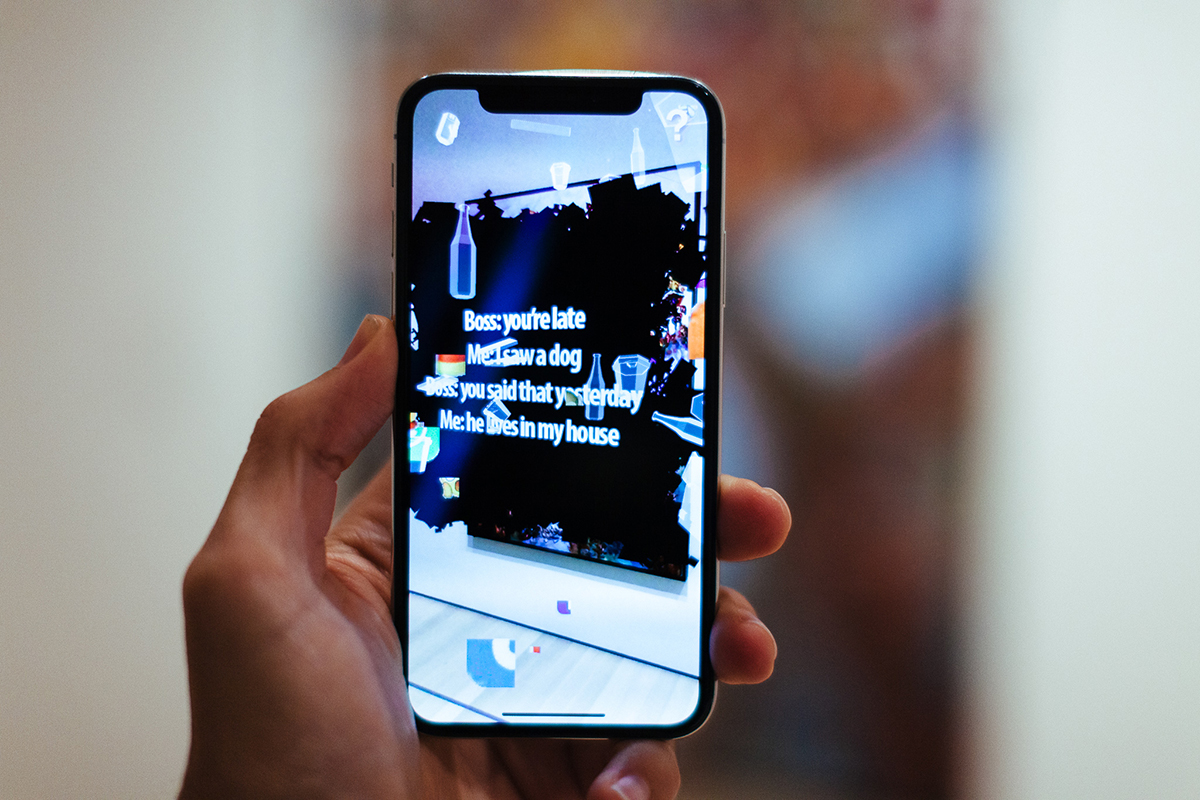“There’s so much modern and contemporary art that isn’t shown,” the mononymous artist Damjanski said as we walked around the fifth-floor galleries of MoMA, iPhones in hand. “What if we could bring even more in?” Along with Monique Baltzer and David Lobser, Damjanski has come up with a solution to these limitations with MoMAR, an “unauthorized gallery” that lives inside the recently-reopened museum from which it derives its name.
The gallery takes the form of an iPhone app that uses augmented reality (AR) to introduce new art into MoMA by latching onto physical artwork as triggers. Initial exhibitions earlier this year featured new works layered on top of the existing paintings, offering a sort of secret secondary exhibition.
For its third iteration, titled Open to the Public, the MoMAR curators wanted to push the boundaries of the museum further, digitally intervening into the museum’s architecture more directly. Manuel Rossner’s contribution, Reef, reconfigures the room it “sits” in. The German artist, who primarily works in virtual reality, has created a colorful cavern that expands beyond the gallery’s wall. Rather than simply replacing a painting, it cannibalizes it, and in turn considers what environments—physical or digital—might be made within the white-walled constraints of the museum. This vibrant, biomorphic intervention, which is algorithmically generated, adds a dash of play to the relatively rigid structure of the institution. One can imagine the artificial depth causing problems for the less attentive, and MoMA does officially restrict panning phones through rooms if you’re filming.

Other artworks cheekily deconstruct our relationships to how we consume (and make) images in the museum. Akihiko Taniguchi has introduced an “augmented selfie” into the gallery, where a 3D avatar of the artist floats in the iPhone’s view. The digital Taniguchi’s arm is outstretched, phone in hand. If you press your screen it will save a picture to your phone and the animated avatar will take a photo too, his virtual self capturing his face in front of a wall of Morris Hirshfield paintings.
Strokes, by the Japanese duo exonemo, is an act of artistic intervention (or vandalism). Just what it sounds like, when an iPhone is pointed at its tag (Joseph Pickett’s painting Manchester Valley) random Pollock-esque strokes of “paint” will appear on the screen, disrupting and damaging the otherwise pristinely kept MoMA and its carefully kept goods.
New York-based Erin Ko’s La Barrera diffuses glitchy fractured signs throughout the gallery—shattered emojis, 3D pyramids and bottles, all what Ko calls “floating garbage.” Black brushstrokes cover a canvas that digitally displays quickly changing insipid networked truisms: “You don’t know stress until you own a charger that only works if your phone is at a certain angle.” Is that stress? By disrupting the art on display and its vaulted home with her own internet throw up, Ko seems to point out the banality of the glut of content online and off, the constant distractions that the privileged find on their phones and in museums, in buildings and on networks developed by so much labor and producing so much waste, all of which so often is ignored. Where some smaller works hang on the wall a hole opens up, a portal beyond the museum, to nowhere real. An outside we can never reach, the hole reveals the museum as a trap.
Despite the ways these works might prod at the museum that made and continues to makes the modern canon, flouting its celebrated art and its architectural integrity, Damjanski noted that he is not anti-museum in the least. He loves coming to the MoMA, but he sees many new opportunities in and beyond traditional institutions. “Museums are so often a one-way conversation,” he pointed out. “We want to see if it could be a three- or four-way conversation instead.” By involving the user and new artists in the museum, disconnected from its official institutional and curatorial structures, a more democratic, flexible, and updatable MoMA—an augmented one—can be imagined. MoMAR also provides and proposes new ways of exhibiting net art and other creative practices that engage with emerging technology that museums, excluding certain projects such as Rhizome, have been relatively slow to keep up with—though there are some net works like JODI’s video My%Desktop in MoMA’s rehang.
Of course, to visit Open to the Public you still have to get to MoMA and pay admission or attend on a free night, which is also when MoMAR hosts its openings. To further the democratizing potential of AR exhibitions, MoMAR’s team offers up its Unity-based platform as an open-source tool so that people around the world can create their own installations and exhibitions well beyond MoMA’s rarefied walls.
Open to the Public
Viewable with the MoMAR app at MoMA, gallery 521, fifth floor
Through January 25, 2020



